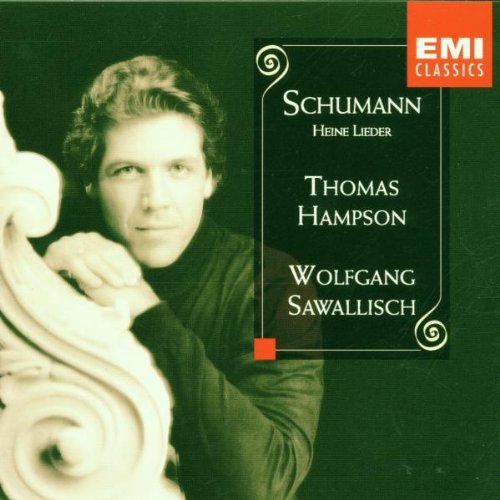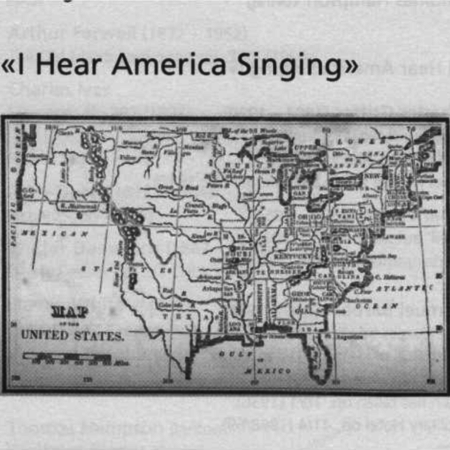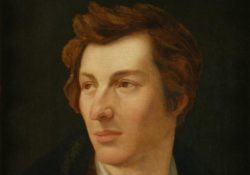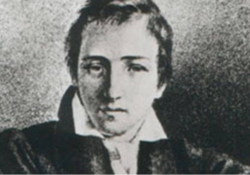An Essay by Thomas Hampson, Renate Stark-Voit, and Carla Maria Verdino-Süllwold
From the liner notes of Schumann: Heine Lieder
“At certain points in time [Heine’s] poetry dons the mask of irony in order to conceal its usage of pain; perhaps for a moment the friendly hand of a genius may lift that mask so that wild tears may be transformed into pearls.” ~ Robert Schumann
Four years elapsed from the time that Robert Schumann completed what he termed his great Heine cycle and its ultimate publication in an altered version as the Dichterliebe. Fortunately for scholars a great many documents from those four years have surfaced, and these, when taken in context, come together to reveal a unique story.
Schumann completed 130 songs in his annus mirabills 1840 – a considerable vocal output for a composer who had previously produced instrumental music. The manuscripts for all of these songs, bound in three volumes, exist in the collection of the Berlin Staatsbibliotek, and it was here under the title Zwanzig Lieder und Gesänge aus dem Lyrischen Intermezzo im Buch der Lieder für eine Singstimme and das Pianoforte that we found the original version of the Heine cycle, composed between May 24 and June 1, 1840. An examination of the manuscript revealed not only the four additional songs, but also a significant number of differences in notation, dynamics, and even text. These differences led us to investigate the reasons for the changes.
We began with Schumann’s correspondence from the period, seeking to place the 20 Lieder in its context. Several interesting clues emerged. On May 25, 1840, for example, when he was already in the process of composing the songs, Schumann wrote to his bride, Clara: “Several days ago a Berlin publisher spoke to one about my songs but I do not like the idea of editing them so much. […] Their name is Bote and Bock.” One day after completing the last Heine song – (Schumann had inscribed “End” after the twentieth song in the manuscript), he sent the following letter to a newly opened publishing house in Berlin:
“I have just now completed a great song work and I am proud to enclose the list of titles; the work itself, shall follow within fourteen days. I would be happy to see this entire group of songs which has been conceived of as a whole to appear in its entirety. […] Concerning the format of the plates I would be pleased with something that looked liked your edition of Kinderszenen. How successful these songs may be in public, I cannot really say. I can say, however, that I have never before written anything with such love as when I was composing this group. With my numerous connecting passages it as also easy for me to create preludes and arrangements for the songs.”
The publisher, however, refused to print the songs because, he said, the cycle was “too significant and in our view not suited to our firm” – probably a euphemism of its being too expensive for a house which preferred to print little piano pieces.
Of the numerous songs completed in 1840, three groups were issued in that same year by three different publishers: the Heine Liederkreis, Opus 24 by Breitkopf und Härtel; Myrthen, Opus 25, Schumann’s wedding present to Clara, as well as Opus 30. Three others – Opus 31, Opus 35, and Opus 37 – followed in 1841 with other publishers, while publication of the rest of the 1840 output was not completed until 1850 – understandable given the number of songs. From 1840 until 1843 there is no further documentation of Schumann’s efforts to get the 20 Lieder und Gesänge published; he appears to have left them untouched. But on August 6, 1843, Schumann then addressed himself to Breitkopf und Hartel in the following letter, which is not without some contradictions:
“May I be so bold as to inquire if you would be willing to print a Lieder work I have written. I have worked on this for two years (!) and tried to sell it and it may be that for the time being I will end my career as a song composer with these Lieder. They are a cycle of twenty songs, which has been composed as a whole, but in which each separate entity represents a complete unit unto itself. If it could be ready for Easter 1844, that would be lovely.”
It is remarkable that an otherwise extremely detailed a composer could have miscalculated by an entire year, and it also cannot be correct that he had been continuously busy preparing these songs. Nevertheless, because he had at the same time offered the publisher songs Clara had written, Breitkopf showed him the courtesy of inviting him to a verbal discussion about his large volume of songs. We do not know whether or not this conversation actually took place, but on August 31 Schumann withdrew his offer from Breitkopf. Finally in October he preferred the cycle to a third firm with whom he had never before worked. This was the house of C.F. Peters in Leipzig, who ultimately did publish the Dichterliebe. To Peters, Schumann offered three works, (among them his Second Symphony); the first of these was his song cycle now entitled Zwanzig Lieder and Gesänge für eine Singstimme mit Begleitung des Pianofortes, Opus 47(!). Peters was willing to print the songs, and Schumann entrusted his copyist with the preparations. In his household accounts for October 26, he has noted costs to Bruckner for copying the Heine Lieder. On November 14 the manuscript was sent to the publisher in its unaltered, unedited form, as we can tell from the fee to which Schumann refers:
“I hereby enclose to you gentlemen my Heine Lieder cycle. On the title page it might be nice, as customary to print the opening lines of the various poems. I confirm the honorarium of twenty gold Louis to be paid upon receipt of the manuscript. I also ask for six free copies. If the cycle can be ready for Christmas to surprise my wife, that would please me, but this is only a wish, not a condition.”
Peters did not succeed, after all, in getting the Lieder out by Christmas, but Schumann, himself, may not have minded as he was busy with other pressing matters. He was preparing for a major trip to Russia, which was to last from January 25 until May 31, 1844; in December, he conducted the Leipzig premiere of Paradies and die Peri – which was a great success and led to his reconciliation with his father-in-law Wieck – and, as Clara’s wedding diary indicates, until his departure he was very busy correcting proofs for that oratorio, which Breitkopf subsequently published.
Nevertheless, he did try to pay attention to the printing of the Heine cycle. In a transcript of a recently discovered letter from December 27, 1843, Schumann requests galleys from Peters:
“Because I am about to embark on a major trip twelve to fourteen days from now, I would be very pleased if I could receive my galleys of the Liederkreis Dichterliebe before I go. In the events that the plates will be finished, could you please send them with someone as quickly as possible.”
This is the first reference to the title Dichterliebe, which does not appear again in any correspondence until August 1844 when the printing of the sixteen songs as Opus 48 was completed and delivered to Schumann and he wrote, asking for his free copies. Implicit in that letter is something Peters’ longtime proofreader Roitzsch is said to have recounted much later: that Schumann made a great many changes in the Dichterliebe in the first set of galleys and then in the final revision so that the first printing ultimately had to be redone.
But what constituted this first printing? It is clear from the aforementioned documentation as well as from the appearance of the manuscript that no changes or shortening of the cycle were made between June 1840 and October 1843. It is further clear that for years Schumann had placed a special emphasis on printing the 20 Lieder as they were intended: a complete cycle. It is also true that for years after the publication of the Dichterliebe Schumann continued to think of the Heine cycle in its original format. A diary entry from July 1846 says:
“I have composed almost all of my works – even the smallest pieces – in an inspired frame of mind, many in a remarkably brief time – my First Symphony in B Major in just four days, a cycle of twenty songs in a very short period, and Die Peri in an even, relatively speaking briefer time. From 1845 onward where I began to find everything there in my brain, I began an entirely new approach to composition.”
Why then the revisions? When and by whom were they authorized? And what was the effect of these changes? The most obvious conundrum is what happened to the four songs which were cut. We only know that they were first published posthumously as part of Opus 127 and Opus 142, and therefore, they are often misconstrued to be late works of Schumann. More difficult to answer is the question of when and why the manuscript was altered because to date there is a dearth of evidence or documents from the time of the actual printing. Not even correction copies are available, as they are for Schumann’s other works. All this opens the door to speculation about the process of changing and editing which took place.
The obvious incongruities and subsequent speculation have been historically a “problem” with the Dichterliebe. The first major study of the two versions, manuscript and first edition dating from 1914 was by a Dr. Viktor E. Wolff. This study, long since out of publication, has been a welcome, clarifying influence on this recording.
Before the above mentioned letters and documents had come to light, the common assumption was that Schumann must have cut the four songs himself, and that the changes were naturally made for the better. The arguments in support of this theory are based on a variety of premises ranging from biographical ones to musical and textual speculations, as if Schumann were trying to manipulate textual sources to his own autobiography. The efforts to establish such evidence tend to lead to an even broader view that a creative person like Schumann thought about his spiritual output at different times in different ways and that with the years it was quite possible he had changed his views about his songs. There is no musical, autobiographical, or historical evidence to be found anywhere, to support the conclusion that Schumann changed his mind or later came to view the cycle with a different purpose. Such arguments are fallacious, and the facts indicate a more complex historical sequence of events. Rather than autobiography, Schumann was interested in articulating his understanding of Heine. From beginning to end, the 20 Lieder and Gesänge is about the great poet’s thought encased in Schumann’s music.
What is it that attracted Schmann to Heine? When, how long, and in what ways did he explore those connections? What did he hope his 20 Lieder would say about his understandings of the poet?
In 1828 the then eighteen year-old Schumann had met Heine in Munich and had described the poet: “On his lips there played a bitterly ironic smile but it was a lofty smile aimed at the trivialities of life and a scorn for petty men.” The notion that Schumann either ignored or tried to soften Heine’s irony is a widespread one that has not been challenged frequently enough. Schumann later referred to the issue of the irony in his writings in almost Heinesque terms – (one can almost imagine the words come from the Lyrisches Intermezzo itself:) “At certain points in time poetry dons the mask of irony in order to conceal its usage of pain; perhaps for a moment the friendly hand of a genius may lift that mask so that wild tears may be transformed into pearls.”
We know that in May 1840 Schumann had begun to set a series of poems from Heine’s Lyrisches Intermezzo, though he had not yet finalized in his mind the exact number or sequence of the songs – a process which would take him a few more days. In the first edition of the Buch der Lieder, which we know Schumann owned and used to compose his cycle, the Lyrisches Intermezzo contains sixty-six songs and a prologue. In this prologue a dreamy poet called a knight, is abruptly catapulted back from the fairyland of his illusions about life and love into a lonely poet’s attic. It is essential to read the entire cycle of poems from this self-ironic premise, and naturally, Schumann had read it this way himself in 1840 when he began to compose. Heine’s poetic diction employs practically the entire repertory of Romantic symbols and images to give the poems a metaphorical dimension as well as to inject into them his own brand of irony. The way Schumann captures these dimensions in his songs belies any naïveté on his part or any lack of understanding of the ironic implications, though the naive label has remained persistently and mistakenly attached to the Dichterliebe. Thus, knowing the original version of the complete Heine cycle contributes to understanding Schumann’s appreciation for and interpretation of Heine.
In the songs which were later cut, the dream world with its shadowy depths is all the clearer, just as it is that much more present in the first versions of the sixteen remaining songs before they were altered. For example, dark intimations already surface in “Dein Angesicht” before peaking in the self-pitying and self-ironic closing lines of “Es leuchtet meine Liebe:” “When I am in the grave, only then will this fairy tale be ended.” In “Mein Wagen rollet langsam” (Nr. 16) there is a close motivic/musical connection to the next song, “Ich hab’ im Traum geweinet” (Nr. 17) that unmistakably demonstrates how the dream of one song influences the next and adds to it another level of meaning. Knowing the original also reinforces the stylistic interconnectedness of the songs and the poems. In the first version the clarity of the text is even more pronounced against the melodic line, and the rhythms are closer to speech. In a song like Nr. 11, “Das ist ein Flöten und Geigen,” the melody – indeed, the entire song – is clothed in a different ambiance. In the manuscript above the postlude, one finds the marking vivat hoch which captures spontaneously and vividly the fluid key structure. The accompaniment in the first version is also often patently unprettified; many dissonances may jar at first hearing, but they very quickly serve to establish the semantic reference. The phrasing of the piano part is frequently rhythmically differentiated, shifting with the fluctuation of the singing voice and therefore the syntax of the German language, as so graphically manifest in a song such as Nr. 14. Some postludes, which were, in fact, longer often belie a youthful search for harmonic inventiveness. Even thematic material often disjointed or isolated in the known Dichterliebe is in Schumann’s first draft actuary more obvious in its connectedness.
Beyond all of these differences, the manuscript of the twenty songs offers its interpreter a few more opportunities to observe divergent details. Persistently repeated printing errors can be corrected by studying the manuscript. Not only did the published version contain printing errors, but some dynamic markings differed; many tempo and phrase indicators from the original manuscript were absent; and the lower-lying tessitura of the original was tailored to fit the treble voice of the piano part
Citing all these details is, in no way, meant to suggest that the “discovery,” performance and recording of the first version of Schumann’s Heine cycle devalues or impugns the significance of the printed Dichterliebe. Rather it argues for the uniqueness and importance of both versions, which, standing side-by-side, illuminate the creative process of one of our great geniuses and enrich the repertory.
File Download
An Essay by Thomas Hampson,
Renate Stark-Voit, and Carla Maria Verdino-Süllwold
Schumann: Heine Lieder
Thomas Hampson, baritone
Wolfgang Sawallisch, piano
Recorded: 1994 / Album Release: 1997
EMI Classics: CDC55598




